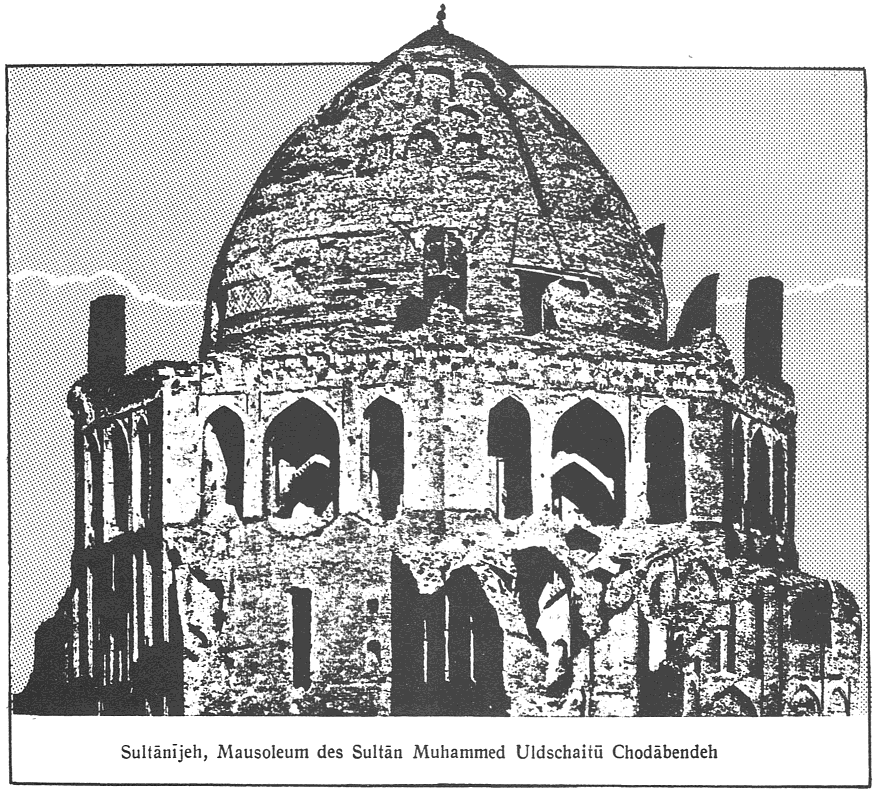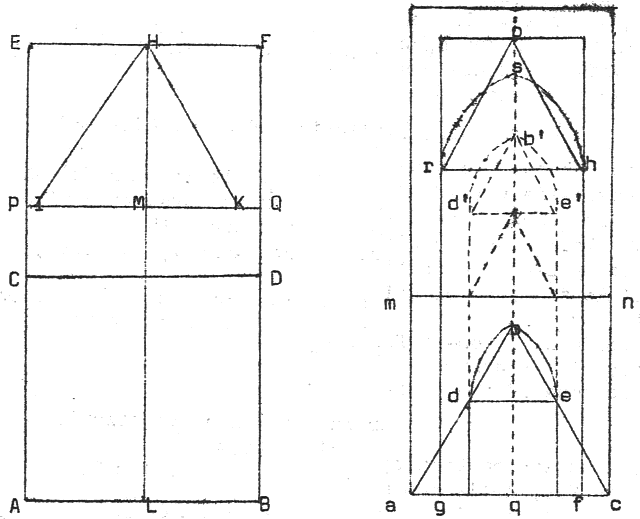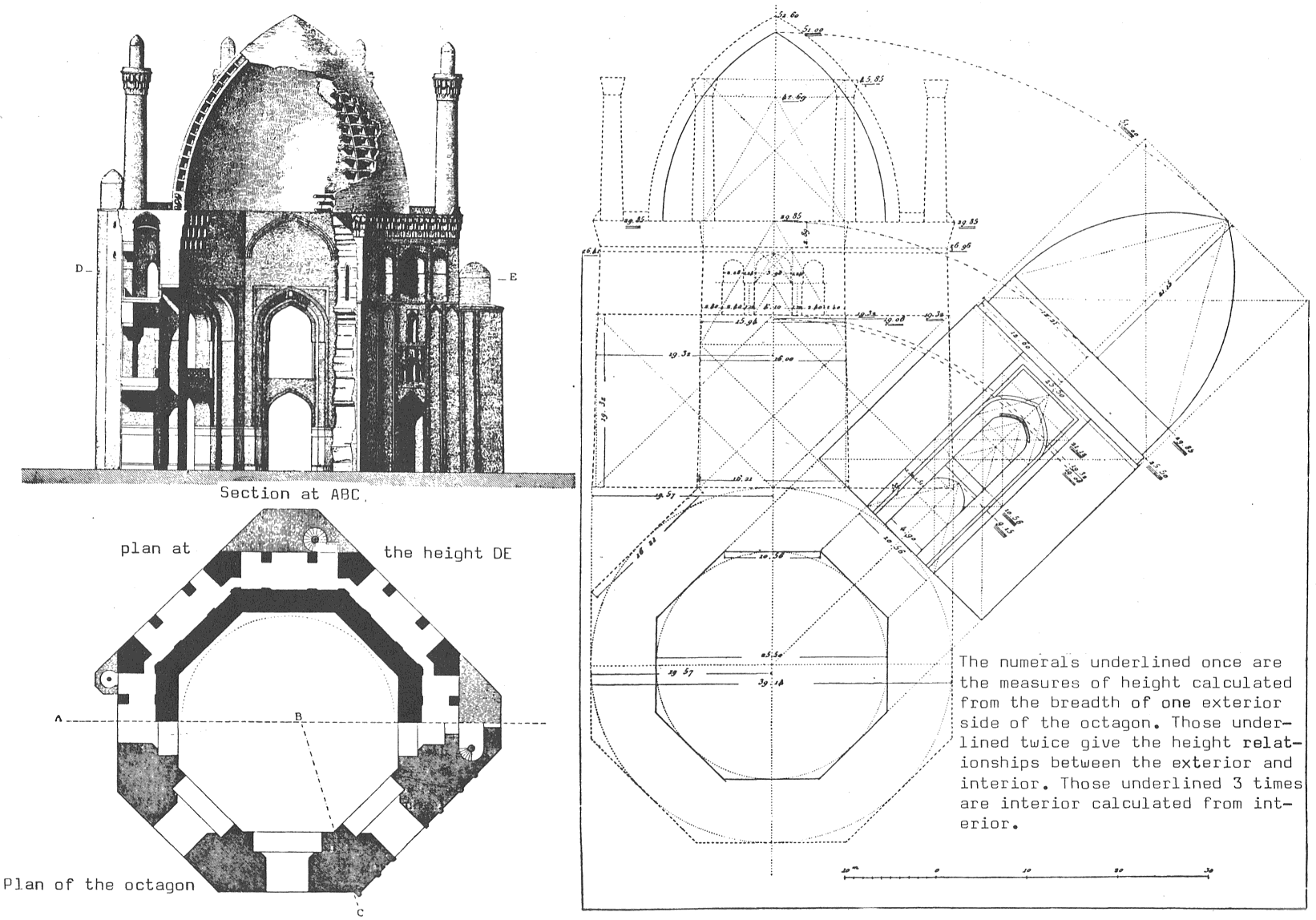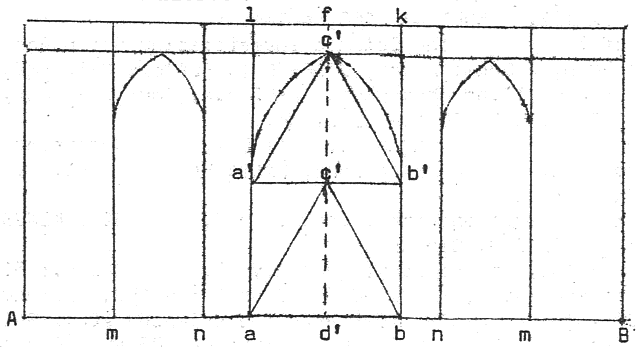
Journal of Geomancy vol. 1 no. 3, April 1977
Translated from Ernst Diez, Die Kunst der Islamischen Völker (1917), pages 82–85.
{61}
A new phase in Persian dome-construction, particularly the building of mausoleum domes, appears in the Mongolian period. Even today its best example is still the imposing mausoleum of Muhammed Uldschajtu Chodabendeh (1304–1316) in Sultanijeh. This prince was a member of the Persian Mongol dynasty of Hulagu and he initiated and completed the building of Sultanijeh (“The Majestic”) for his residence. The octagonal building differs from earlier ones chiefly by its strong emphasis on the dimension of height, which therefore fades into the pointed dome and the eight corner pillars. Mausoleum domes with the roof as rafters of the dome had not occurred before that time in Persia, although they appear in the ruins of Old Delhi, among the Pathan graves of the 14th–15th centuries, which with their total layout drawing its inspiration from the Iranian highlands, bear a certain resemblance, but are, of course, in stone. The structure of the facade comprises 2 storeys with an arrangement of tiles, as is the case in Tus. The third storey crowns the eight-sided building with a row of dark embrasures which light the gallery.

As an instructive example of the ratios of size of Persian domed buildings, in what follows I give the results of an exhaustive study of this memorial undertaken by M. Dieulafoy (cf. Revue Générale {62} d’Architecture; 1883). The total height of the building is 51 m, the interior diameter 25·5 m. Already in the relationship of these two numbers are indicated strictly observed ratios of size, to which Persian buildings, like those of the ancients, owe their perfection of form. The mean diameter of the pillars served the Greeks as modulus; the Persians for their part sought to bring the diameter of the arches or domes into determinate relationships with the other parts of the building. In Sultanijeh the basic measure was the inner diameter of the burial hall.

On the base AB the architect constructed a square ABCD, above that a second, CDEF; within the latter an equilateral triangle IKJ, whose base IK gives the opening of the dome. (see above). The polygon APIHKQB yields the schema of the interior. The line CD gives the lower border of the ledge, whose thickness is defined by the field CDIK. The interior is octagonal; one side of the octagon serves to determine the dimensions of the side-chambers and galleries. One side ac served as base for an equilateral triangle abc, whose vertex b yields the height of the ground floor pointed arch and whose side de of the inscribed square yields the width of the arch. The side ac of the octagon, when raised to a square by mn, gives the base of the upper galleries, the height of whose arches corresponds to twice the height of the triangle deb. The great arch rhs was constructed parallel to the arch d′b′e′ and its vertex s is as high as twice the length of the octagon side ac. Before restoration of the building, the height pq was equivalent to twice the length gf, i.e. the inner measurement between pillars, plus the height of the equilateral triangle rhp when placed on top of it.
But in the 16th – or more probably the 17th – century, the frame was lowered and set directly on the arch (see diagram below) to give greater prominence to the frieze which runs over it. (Here we see a characteristic wilfulness of the restorer, common in Europe also, which at the same time gives a persuasive stylistic criterion for the Safavid period!). Although this alteration can perhaps be integrated in the harmonic system of the mausoleum’s interior architecture, it is nevertheless not so lawfully deduced from it as the earlier arrangement; also it has a more unfortunate effect: the frame weighs {63} on the backs of the arches and is forcing them down.

On the exterior the level of the upper platform which terminates the height of the building was designed to be at the same height as the outer and inner rim of the dome, so that the outer and inner constructions were linked in the most rational manner. The exterior sides of the octagon were so arranged that the sum of the heights of the square and the equilateral triangle on any one side were equal to the total height of the building (minus the dome). Without doubt the architect laid great importance on this last dimension (the side of the octagon), for it also served to determine the heights of the minarets on the terrace. (height of minaret = side of octagon). The exterior galleries took up the whole depth of the walls; their pilasters must have rested on the arches of the interior galleries. They were constructed at one and the same height, equivalent to half the average breadth of the building, i.e. at a height of 19·32 metres, 27 cm higher than the internal vertices of the galleries. The care that was taken in proportioning the greater contours of the building is reproduced in all (smaller – P.J.) details. As an example, the numerical relationships found in the arches of the external gallery will suffice. The breadth ab of the middle arch (diag. below) is ¼ of AB, the side of the external octagon; that of the side arch, mn, equals the widths Am and Bm, the corner pillar is one seventh of AB. The height, cd, of the great arch is the sum of the heights of two equilateral triangles on ab, whilst the sum of the heights of such a triangle and of a square on ab gives the distance df of the base of the ledge over the gallery.

All the series of pillars are constructed, geometrically speaking, from the same elements. The height of the corner piers and pillars is equal to the height of the square or of the equilateral triangle on the base of the arch (sic – P.J.). The arch-head is determined by the height of the equilateral triangle on the same base. The beginning of each arch is clearly indicated by an ornament on the base of the triangle. This construction is common to the openings of arches on all monuments of the Mongol period. In buildings older than the 13th century, the arch is often twice as high as it is wide, but the arch-head is invariably at the height of the equilateral triangle inscribed in the curve of the arch; a vertical section of the dome in Sultanijeh was also constructed according to this principle. These characteristics are all the more typical for the fact that the four-centred Gothic arch (Tudor Arch), which was used on all Persian buildings after the 12th century (in fact, the 11th century!), is inscribed in a semicircle and the geometrical origin-points of the arches never agree with those indicated by the construction.
A new feature of this mausoleum is the construction of the dome, which for the first time lifts itself free from the disguises which hitherto had buttressed it out of existence. In order to accommodate {64} its weight as much as possible, the master builder placed the dome on two curved concentric slabs each of 33 cm thickness, linked by a lattice of timbers. To channel its shearing action more completely into the wall piers, he set the dome on the interior edge of the octagonal base and shored up the projections by a cellular frame; he also elevated the eight pillars corresponding to it by adding minaret-like roofs to them.
Thus in Persia a constructive system had arisen from the static demands of constructing a central dome, a system which Dieulafoy rightly compares to the Gothic system.
////////////////////////////////////////////////////////////////////////////////////////////////////////////////////////
Editor’s note: The Octagon at Ely shows several close similarities to this mausoleum
(J. Geomancy 1/1 p. 17–20),
having been completed only a few years later.
The architectural connexion, transcending sectarian or religious differences, emphasises the universal nature of sacred geometry.